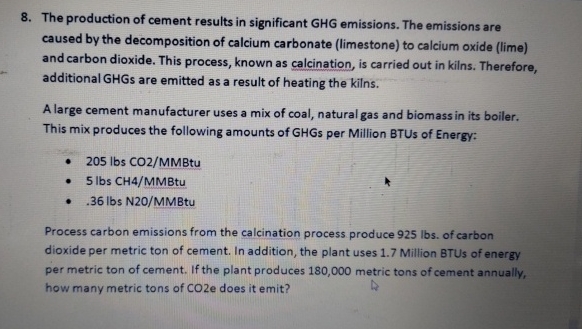Answered step by step
Verified Expert Solution
Question
1 Approved Answer
The production of cement results in significant GHG emissions. The emissions are caused by the decomposition of calcium carbonate ( limestone ) to calcium oxide
The production of cement results in significant GHG emissions. The emissions are caused by the decomposition of calcium carbonate limestone to calcium oxide lime and carbon dioxide. This process, known as calcination, is carried out in kilns. Therefore, additional GHGs are emitted as a result of heating the kilns.
A large cement manufacturer uses a mix of coal, natural gas and biomass in its boiler. This mix produces the following amounts of GHGs per Million BTUs of Energy:
COMMBtu
MBtu
NMMBtu
Process carbon emissions from the calcination process produce of carbon dioxide per metric ton of cement. In addition, the plant uses Million BTUs of energy per metric ton of cement. If the plant produces metric tons of cement annually, how many metric tons of does it emit?

Step by Step Solution
There are 3 Steps involved in it
Step: 1

Get Instant Access to Expert-Tailored Solutions
See step-by-step solutions with expert insights and AI powered tools for academic success
Step: 2

Step: 3

Ace Your Homework with AI
Get the answers you need in no time with our AI-driven, step-by-step assistance
Get Started


